Today we’re talking about how to manage a reactive dog in an apartment. If your dog is reactive, we offer some ideas to help!
This can be tricky because reactive dogs need space, and there usually isn’t a whole lot of that on apartment grounds!
However, reactive dogs are usually manageable with the right tools, a basic understanding of what causes the behavior and the willingness to help them overcome their reactivity.
Consistency is equally important, so make sure everyone who handles your dog knows your routine and hacks. This includes your family members, friends, and dog walkers or pet sitters.
Essentially anyone who’s in charge of taking your dog in and out of your apartment besides yourself.
I’m Barbara and I write regularly for That Mutt. I’m also a blogger over at K9s Over Coffee.
My dogs Missy & Buzz
When my former pups Missy & Buzz, my two Boxer mixes, came into my life at 8 weeks old, I lived in an apartment complex in Northern Virginia. On the third floor, to be specific, with neighbors below us and next to us.
My pups were super friendly towards most people, kids, and dogs because they experienced them on a daily basis right from the get-go. It made socializing them very easy because there was always someone we’d run into.
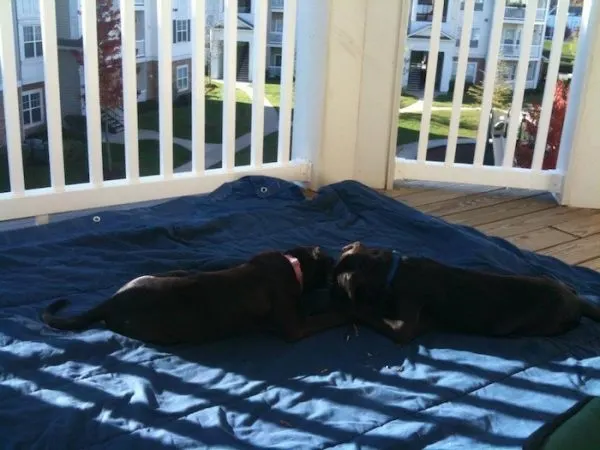
But every now and then, they weren’t overly crazy about other dogs that were aggressive, especially as they grew older.
We had several reactive dogs who lived in our apartment complex, and although I did my best to avoid them, it wasn’t always possible. So I needed something to help me get through the moments when we did run into reactive dogs.
My two favorite tools were doggie backpacks and Haltis. More on that later!
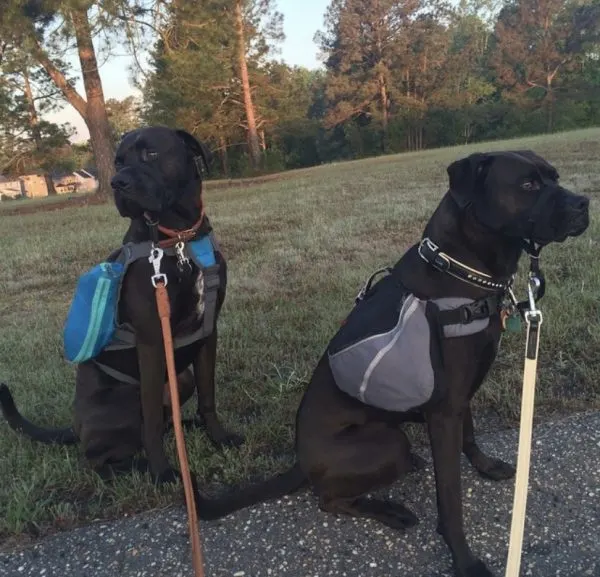
What causes reactivity in dogs?
There’s always a reason why dogs are aggressive, and it’s usually fueled by fear.
Fear is often caused by bad experiences or a dog’s lacking in socialization. It can also be caused by an overly anxious owner.
For example, if your dog wasn’t properly socialized as a puppy and was never around men with beards, screaming kids or the sounds of construction, he’s potentially going to be fearful or unsure of those things. This falls into the category of lacking socialization.
If a kid ran your dog over with a bike, he’s potentially going to be fearful of bikes, and maybe also kids.
Or maybe there was an incident at a local dog park where your dog got attacked by a big, black, female dog. This would explain why your pup now acts up whenever he sees a big, black, female dog approach him. This falls into the category of bad experiences.
Dogs are incredibly in tune with our body language and energy, which is why a shy dog can also become fearful if her owner is overly anxious when other dogs are around or whatever else causes the owner anxiety and fear.
That fearful energy travels particularly well through a leash, especially when it’s held tightly and there’s a lot of tension on the leash. This falls into the category of fear caused by a fearful owner.
Also, keep in mind that sometimes dogs act aggressive or fearful, and we just don’t know why.
What triggers YOUR reactive dog?
That being said, every dog has their very own triggers, so you’ll have to figure out what triggers your particular dog. I suggest taking mental notes whenever your dog starts going into his reactive mode. Once it’s safe, write them down. From there, you’ll be able to figure out a pattern and develop a plan of action.
If you notice that your dog is triggered by something particular on your walk like other dogs walking your way, see about asking a friend or family member if they can follow you and videotape the reactive scenario.
It’ll be helpful to watch and analyze it after the walk, possibly along with the help of a professional dog trainer or animal behaviorist.
You might notice that your pup is just fine when the oncoming dog is still 50 yards away, but that he starts tensing up when the distance between them is less than that.
In the meantime, do a little brainstorming and ask yourself what might be triggering your dog.
Potential triggers for an aggressive dog in an apartment:
- Other dogs in general
- A specific type of dog
- Other people in general
- Delivery people wearing a uniform like your UPS or FedEx guy or gal
- Men with beards and/or hats
- Kids on bikes/ rollerblades
- Screaming kids
- Specific sounds like construction noise, a motorcycle, footsteps, doorbells
- Barking dogs
- A janitor pushing a cart or holding a mop
Once you’ve narrowed it down, you can actively start working on helping your dog overcome his fears.
Don’t be angry with your reactive dog
I’d like to through in a word of caution about your own reaction to your reactive dog. Your best bet is to be calm, yet assertive. Don’t be angry with him. It’s not like he’s born that way, which is why anger won’t get you anywhere, other than in potential trouble.
Understand that dogs mirror our emotions and interpret our body language. Therefore it’s a lot better to stay as calm and collected as possible because it will rub off on them.
I know that it’s not always easy or possible, but even if you do get worked up, try to remind yourself to take a deep breath and refocus.
Also understand that a dog who feels pushed into a (literal or physical) corner by an angry owner can bite!
So rather than be angry, try to understand where your dog is coming from. After all, he has a reason for (re)acting the way he does, so you’ll need to play Sherlock Holmes and get to the bottom of his reactivity issues.
Remember, it is absolutely not personal! Dog’s are animals and they simply react to the situation.
Tips to manage your aggressive dog in apartments
Ideally, you’ll want to work towards overcoming your dog’s fear. To do this, he’ll need to be exposed to his triggers and work through them.
It’s best to hire a professional dog trainer or animal behaviorist to help you with this task, especially when you’re dealing with a truly aggressive dog. However, there are also books that can offer guidance and help point you in the right direction.
Books that can help a reactive dog
Both are by Dr. Patricia McConnell. She is an applied animal behaviorist and works with reactive and aggressive dogs. But either way, it’s still a good idea to get objective feedback from a neutral person like that live animal behaviorist standing right next to you.
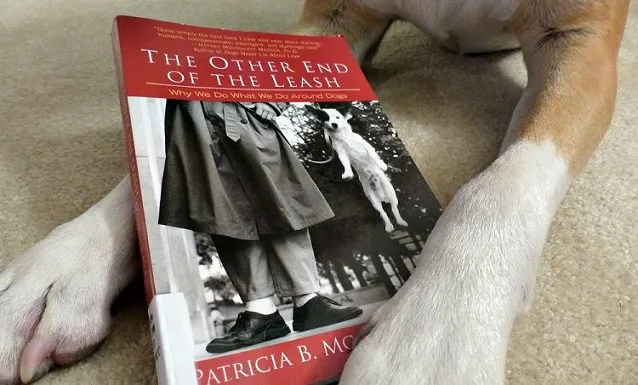
It’s important to understand that this isn’t something you can “fix” overnight as it will take some time, so it’s important to be patient and also to expect some setbacks.
In the meantime, you’ll need to be able to control your dog’s reactivity because reactive dogs can definitely be dangerous, especially when they’re larger.
After all, things can potentially escalate and result in a bite. For this reason, it’s also a good idea to be up to date on your dog’s core vaccinations.
You don’t want to be held liable in case someone gets bitten by your dog and you can’t provide his vaccination record.
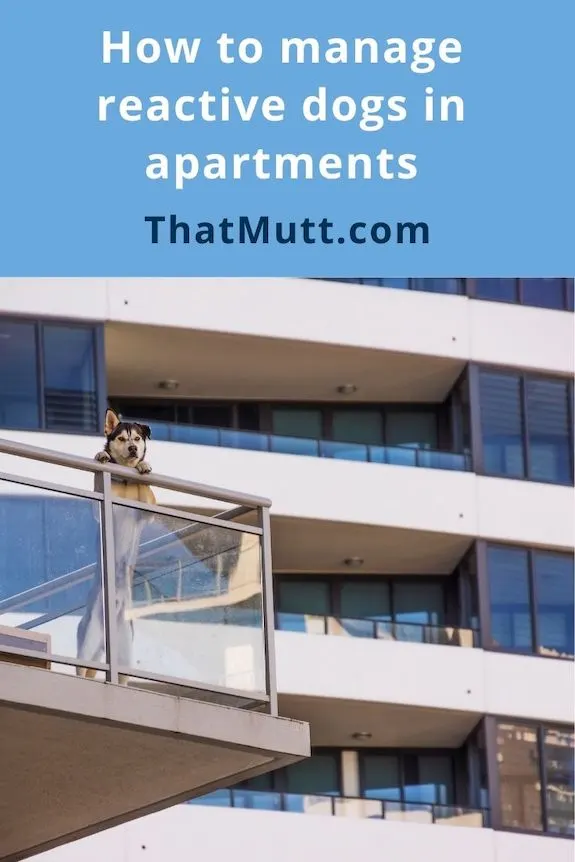
Tools that help control your reactive dog outside:
Muzzle for a reactive dog
For really bad cases where your reactive dog could truly do some damage if he bit someone, your best bet is to muzzle him when you take him outside. This may also be the law if your dog has a history of biting.
See our post: How to get your dog used to a muzzle
Gentle Leader or Halti
Gentle Leaders and Haltis are two brands of “head collars” that make it easier to control your dog when they go into reactive lunging mode.
Or when their prey drive kicks in and they want to chase a bunny or squirrel. They really help avoid pulling in general!
Other training collar options include prong collars, martingale collars or e-collars.
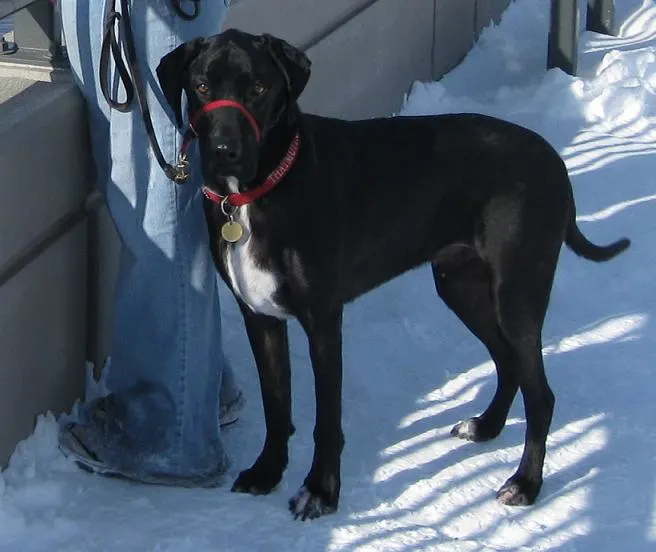
Dog backpacks for reactive dogs
Put a backpack on your dog when you go out for your daily walks and hikes. They’ll tire him out more and make him focus on the job of wearing/carrying something.
Dogs who are tired are less likely to act up, so you might notice that your dog reacts to his trigger(s) more towards the beginning of a backpack walk, but not 45 minutes into the walk.
I personally like to combine the backpack with the head collar. I got Missy and Buzz a backpack each the minute there were old enough to carry them, at around 8 months of age.
When I adopted my new dog Wally, I also immediately got him a backpack. It helps him focus more on me than his squirrel prey drive and other dogs.
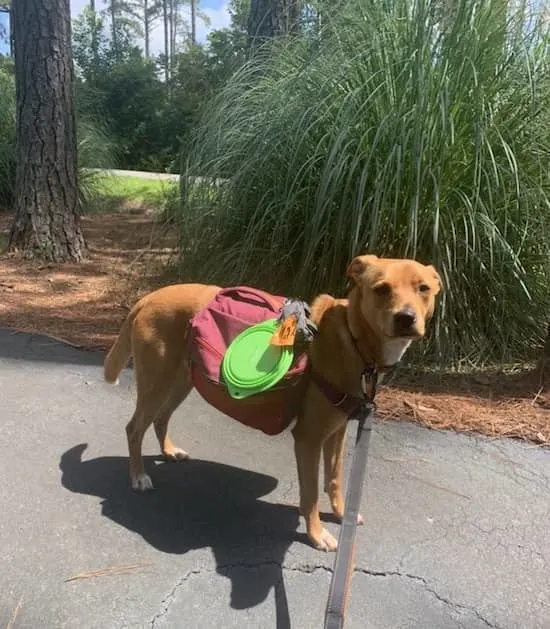
6 ft leash with two handles
Your best bet is to keep your dog next to you and don’t let him roam ahead of you. That’s much easier to do with shorter leashes than it is with longer ones. It’ll be even easier when you walk your pup on a leash with dual handles.
They’re designed to be used in high traffic areas or with reactive dogs. Just grab the handle that’s closest to your dog’s head when you need him right next to you.
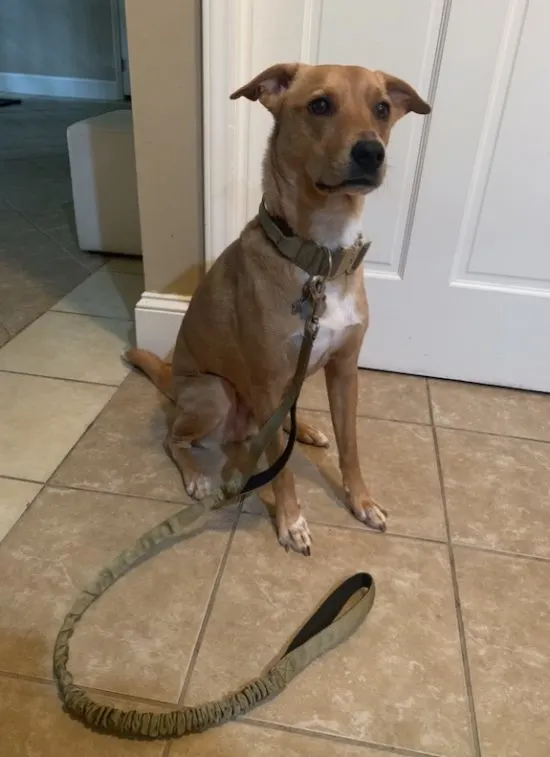
Use leashes that are gentle on your hands
If you use nylon leashes, go for ones with padded handles. The dual handle leash I just mentioned has padded handles. Alternatively, I’d recommend leather leashes. Your hands will thank you!
Avoid retractable leashes, even for small dogs
Retractable leashes have their place, but they simply don’t offer any control over your dog and can easily become tangled with another dog’s leash. They can also cause rope burn and seriously hurt you or your dog.
See our post: Retractable leashes, what not to love?
Obedience commands
Teach your pup leave it, off, place, watch me. Don’t forget to reward your obedient pup with verbal praise and/or high value treats worth listening for. I’d carry a treat pouch on me for easy treat access.
Emergency u-turn for your reactive dog
Teach your dog an emergency u-turn to easily avoid confrontations.
To do this, keep your dog by your side and teach him to watch you/pay attention to you. That way, he’ll easily be able to follow your lead when you decide it’s best to turn around and walk the other way.
Do this when you see an oncoming dog and there’s nowhere to go other than back from where you came in order to keep your pup from reacting. For example, when you’re walking on a narrow path or street, or also in a hallway.
What to do at corners, stairwells, and elevators
It’s easiest to control your dog when he’s right next to you, so I recommend keeping your dog at your side rather than letting him walk ahead of you.
That’s particularly helpful when you’re walking up to blind corners and stairwells where you can’t tell who’s going to come your way.
Keep dogs on a 6 ft leash
I recommend using a dual handle leash or a short traffic handle dog leash to help you keep your pup right next to you. Both are designed to easily navigate your dog through high traffic/distraction areas.
A traffic handle dog leash works well with medium to large and extra large dogs, but is not a good option for small dogs because you won’t be able to hold the leash comfortably due to its very short length.
For smaller dogs, a 6 ft dog leash with dual handles will be a better option. I don’t recommend using retractable leashes in those settings because they can so easily tangle as well as jam.
I also don’t recommend carrying your smaller dog in your arms if he’s reactive towards other dogs or people. That’s because his elevated position will reinforce his behavior. It’s much better to keep him on the ground and leashed.
For tiny dogs who bark their little butts off, you could use a carrier to get them more easily in and out of the elevator.
As far as elevators are concerned, I’d first recommend using the stairs instead whenever possible.
However, I do realize this is not always feasible. For example, if you live in a multi-level high-rise and don’t want to climb 20+ levels of stairs with your pup, especially if you or him have trouble getting around.
Waiting for the elevator with your reactive dog
When you really do have to take the elevator, keep your dog leashed, on a Gentle Leader or Halti, and very close to you, but try not to put too much tension on the leash.
Wait for the elevator to arrive from a distance, ideally 5-10 feet away, with your dog sitting next to you. Reward with high-value treats. That way your dog won’t be able to get to another dog or person exiting the elevator.
If your pup is dog reactive and you see another dog inside when the doors open, wait for the next one.
Taking the elevator
Keep as much distance away from other people (and their dogs) when you’re riding the elevator, use your body to block your dog from others, and put him in a sit-stay.
Reward with high-value treats and verbal praise whenever he makes eye contact with you. Good boy!
Also, don’t be afraid to tell people and kids not to pet your dog if he doesn’t care for it.
Be polite, yet firm.
You could also have your pup wear a vest with patches that say In Training – Do Not Pet or something similar. That should discourage most people from invading your pup’s space. You can find those on Amazon.
Another option to avoid elevators in a high-raise is to move to a lower floor. Even if it’s not the first floor, it’ll be much easier to walk up and down 2-3 flights of stairs as opposed to 20+.
Last but not least I suggest practicing your elevator routine when you’re less likely to run into other people. For example, during later evening hours or when most people have left for work.
Of course this can be a bit trickier lately when many people work from home.
What to do at the potty area
Larger apartment complexes typically have a variety of paths lined with poop stations, meaning it’ll be fairly easy to avoid other dogs and/or people. Remember that emergency u-turn I mentioned earlier should you need to “escape” quickly.
However, smaller apartment complexes usually don’t have that many potty areas, so you’ll be more likely to run into other dogs and their owners if you live in a small community.
For that scenario, you can use a lot of the techniques and tools I’ve mentioned so far when you’re taking your reactive dog to potty.
Start by keeping your dog next to you, and use your 4- to 6-ft leash with dual handles or a short traffic handle leash. Additionally, use a head collar or a training collar to increase the level of control you have over your dog. If he has a history of biting or you expect that he may bite, muzzle him.
If the potty area is busy, wait your turn and put your dog in a sit-stay 10-15 feet away from the area. Put a vest on your dog with patches that say In Training and/or Do not pet do discourage people from approaching you and your dog.
It’s also a good idea to teach your pup a potty cue. This could be something like Get Busy, Go Potty, or whatever you want him to associate with taking care of business. That way, he’ll know to pee and/or poop relatively quickly which will shorten the amount of time you’re spending at the potty area.
You can always ‘pick up’ later
Make sure to always carry poop bags on you and to clean up after your pup, but don’t make it a priority when your pup is acting up. You can always come back and pick up when he’s calmed down or you’ve taken him back inside.
Don’t worry about what other people think. Who cares if they think you’re “not going to pick up” as long as you do go back and get it shortly.
What to do about noises in the halls that trigger your dog
There can be a variety of noises in the halls, but the most common ones are:
- slamming doors
- doorbells
- elevator doors opening and closing
- screaming kids
- loud neighbors
- construction work
- and barking dogs.
Back in my apartment days with Missy and Buzz, the neighbors who lived right below us drove me nuts. They had two smaller dogs who RACED around the apartment several times per day, and although they rarely barked, we’d hear that muffled thump thump thump thump of their galloping paws on the carpet.
Super annoying, and potentially trigger-ish for Missy and Buzz. However, since they were still really young puppies, I used the sounds in my favor and dished out treats for a while whenever they happened. That way, the pups learned that galloping thump sounds meant they were in for a treat, quite literally!
That said, there are two main options to work through sounds like these: managing and desensitizing.
Tools that help control your reactive dog inside
- Crate as a safe place. It’s a good idea to offer your dog a safe space like his crate. That way he can retreat to his safe space when he hears the sound he doesn’t like.
- Essential oils. Try calming essential oils like lavender and bergamot. They’re known to work well on anxious and fearful pups and can easily be used with a diffuser.
- Calming music. You can also mask the sound with soothing sounds like calming music. I discovered hours of calming doggie music on YouTube when I was looking for ways to mask our neighbors’ noise.
Here’s a video showing the calming music for dogs. Heck, it calms me as well!:
Desensitizing your dog to the noises
Ultimately what’s going to help your dog the most is getting used to the sounds to the point where he’s no longer bothered by them. To achieve this, give your pup high value treats when the noise occurs. This will teach him to associate the noises with something positive, the tasty treats.
You can also practice with similar sounds on YouTube. Play the sounds while offering your dog the high value treats. This is a more proactive approach because that way, you’re not just relying on desensitizing your pup when the noise happens in the halls.
What I did to control the neighbors’ galloping dog sounds
Lots of exercise. This may seem like we fled the noise scene, but that’s only partially true since the galloping sounds happened multiple times throughout the day, so leaving every time it happened wouldn’t have been feasible.
It was also happening when I left the house and the pups stayed home alone, so there was always that part of the equation. Regular physical (and mental) exercise tires your dogs out and makes them much less likely to act up, which helped keep Missy and Buzz calm.
Crates. The pups had their respective crates set up in the living room. I turned them into cozy spaces with comfy blankets and safe doggie chews, usually filled Kong toys. Tip: You can put a blanket over your dog’s wire crate for less visual input if necessary.
Calming music. I mentioned the doggie music I found on YouTube earlier, and that’s exactly what I played when I left the pups home alone. Alternatively, you can also play calming classical music or the kind you’d use to meditate or help babies sleep.
Tip: A different type of white noise can be a running dryer. You could set your pup’s crate up in the laundry room and dry a load of laundry to tune out whatever sounds that scare him.
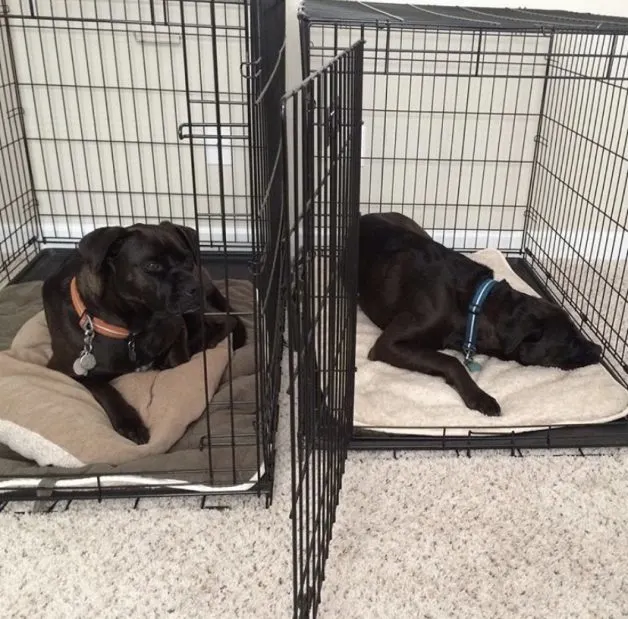
Talk with neighbors – explain, know their routines
Last but not least, try to talk with your neighbors and let them know about your dog’s reactivity. This is probably not going to be a fun conversation, but one that can eliminate potential problems down the road.
Who knows, maybe they also have a reactive dog. Or maybe they’re afraid of dogs and would have reacted in a way that only made things worse for your pup had you not explained yourself. Chances are that they’re going to be thankful that you started the uncomfortable conversation.
When you talk to them, ask about their routines with their dogs. For example, at what time they usually take their pup out in the mornings and at night, what their favorite potty area is, and how they’re handling things with their reactive pup.
That way, you know how to avoid them. Maybe you could even start a self help group and hire a dog trainer together!
My example
In case you’re wondering if I talked to my neighbors about their galloping pups – I did.
As a matter of fact, I asked if they could please limit their dogs’ racing at least in the early morning hours and at night, but they got defensive and weren’t very cooperative.
So that conversation went sideways, and it’s something to prepare for as well. But it doesn’t hurt to start the conversation.
My guess is that most people will be somewhat reasonable. If things are really bad, ask your property manager to move you into another unit, or consider moving somewhere else.
Now we’d like to hear from you! Do you have experience with reactive dogs in apartments, and how did you handle things?
*Enjoying this article? Get realistic dog training tips emailed once a week. Click Here
Barbara Rivers writes regularly for That Mutt. She is certified in raw dog food nutrition from Dogs Naturally Magazine and the author of three ebooks about balanced raw dog food. She is a blogger at K9s Over Coffee.
Related posts:
- Hyper Dogs in Apartments
- Easy Socialization Tips For Dogs And Puppies
- 5 Socialization Mistakes That Could Screw Up Your Dog
- My Dog Is Aggressive At The Vet – What To Do?
- What Should I Do When An Off-Leash Dog Charges Me?
- Why I Use A Head Collar For Dogs – Halti Or Gentle Leader
Get all of our training tips HERE
